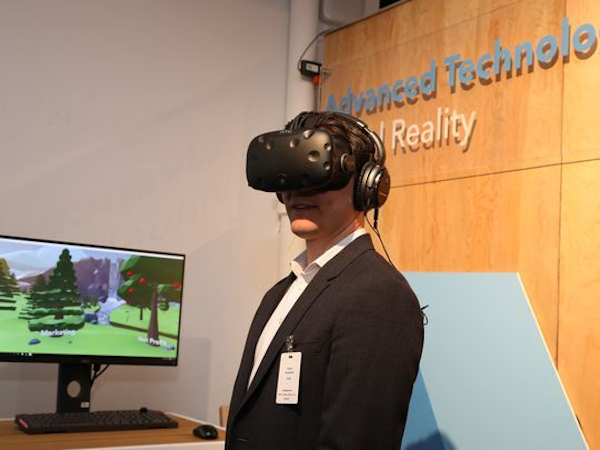[Here’s another (somewhat surprising) application area for presence… This story is from USA Today, where it features two more images. –Matthew]

[Image: Using VR glasses to visualize finances. (Photo: Amy Sussman, AP Images for Intuit Quickbooks)]
Doing your bills is painful. Virtual reality could make it less so
Edward C. Baig, USA TODAY
Published April 5, 2017
NEW YORK—You stare into the bathroom mirror while shaving and ask aloud, “Who owes me money?” A moment later a graph appears on the surface of the mirror revealing the people or companies that owe you, or your small business, the loot.
A prototype of just such a smart mirror was among the futuristic scenarios showcased by Intuit during a recent Manhattan event demonstrating how current and emerging tech could be employed to help business owners and individuals manage their finances. Various demos touched on virtual and mixed reality, chatbots, facial recognition, blockchain (the underpinning for Bitcoin), machine learning and artificial intelligence.
“We won’t invent the mirror,” Intuit CEO Brad Smith explained during an interview. “We’ll figure out how the mirror, plus our stuff, will help you solve the problem.”
Intuit is a 34-year old company born in the MS-DOS age with Quicken personal finance software. Quicken has since been sold, but the company’s popular flagship software these days includes TurboTax and QuickBooks, as well as the online Mint personal financial management service. Smith says 40% of the nation’s taxes involve the company’s software.
Intuit’s chief mission is to simplify finance for the many consumers and business people who would rather endure a root canal than tackle taxes, payrolls, inventories and other stress-inducing financial matters. For such folks, managing personal and business finance is boring, scary, intimidating, complicated or all-of-the-above.
“You ask (owners) about their business and their eyes light up with passion,” Smith says. “And then you ask them about doing their accounting and how they’re going to market and you see their eyes go dull. It’s almost like their dreams get squashed.”
Take inventory management, which Smith insists is one of the chores business people detest the most, “because instead of being that beautiful glass pumpkin (that they) built, it becomes a 3 on a spreadsheet.”
That’s where virtual reality could potentially help. The way Smith sees it, a small business owner would put on a VR headset to visualize “if-then” statements—that is, if you choose to do this or that, what would the impact be on the company’s finances? The owner could manipulate virtual representations of the company’s product, the glass pumpkin in his example, moving items, say, from one virtual shelf to another. As they do so, QuickBooks updates the accounting. “It’s a way to bring finances into a more tangible world,” Smith says.
At the New York event, guests were able to don HTC Vive headgear to enter a world in which the metaphor of a forest was used to make finances come alive. The river in this virtual forest represented cash flow. And based on the financial decisions that a user made, trees in one part of the forest might thrive, while others fail to grow.
During another demonstration, Intuit showed how software might be used to scan your face, all to determine whether you are happy, scared, or in some other emotional state. How might mood detection be useful down the line? An accountant who is outlining, say, a tax scenario for you would be able to tell through the software if you’re understanding what he is telling you, or whether he must do a better job of explaining things.
Not all the tech shown was futuristic. Intuit pointed out, for example, that Mint customers can now pay bills on an Apple Watch.
Meantime, Intuit’s cloud-based QuickBooks Self-Employed is targeted at the 36% of the nation who work for companies such as Lyft, Uber or DoorDash. According to Smith, one of the biggest problems such drivers face is separating personal drives from the trips they make for work. The solution is Tinder-like behavior: through the app on your smartphone you swipe left to indicate that a transaction is a business expense and swipe right if the trip was personal. Smith says the app is the fastest growing in the company, and is saving the average self-employed person $4300 in taxes.
Of course, there could be unintended consequences to the futuristic stuff. If your financial picture is bleak when the smart mirror reports all the people who owe you money, you just might cut yourself shaving.